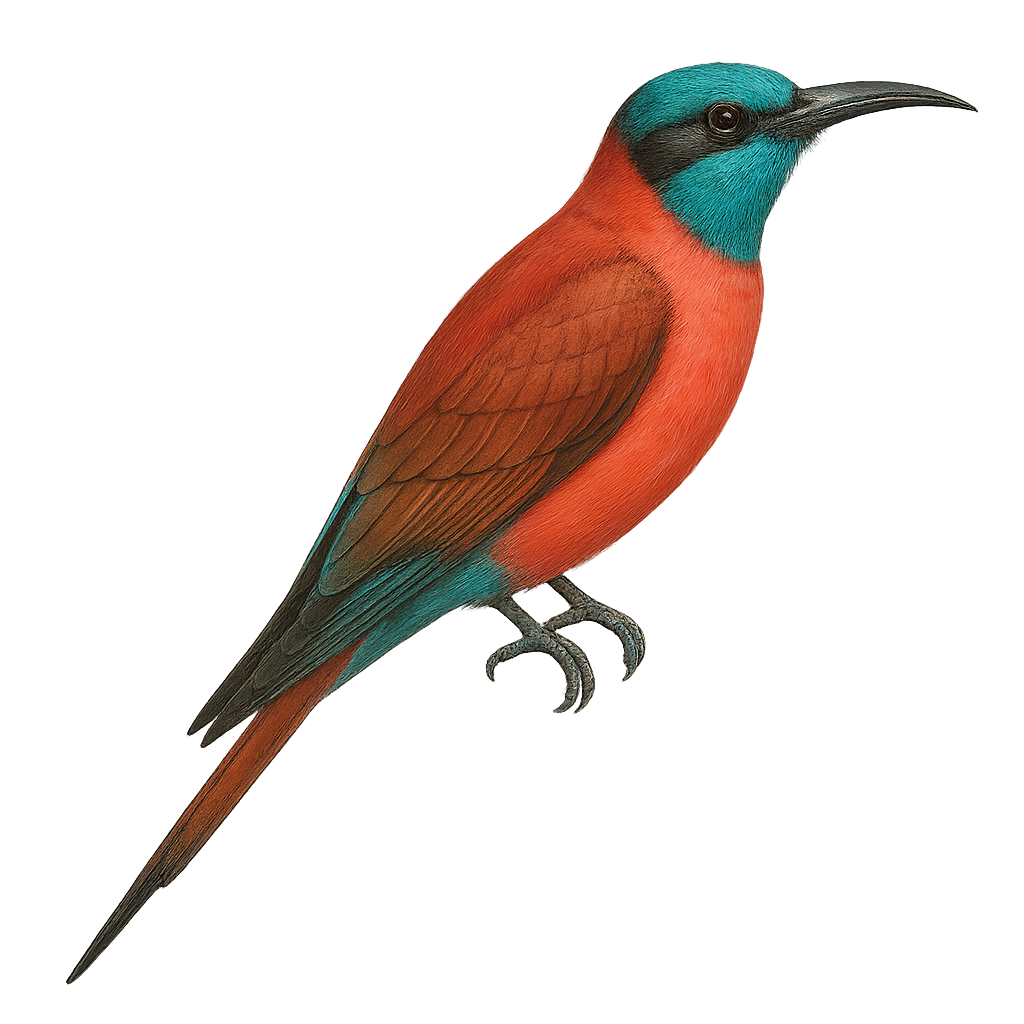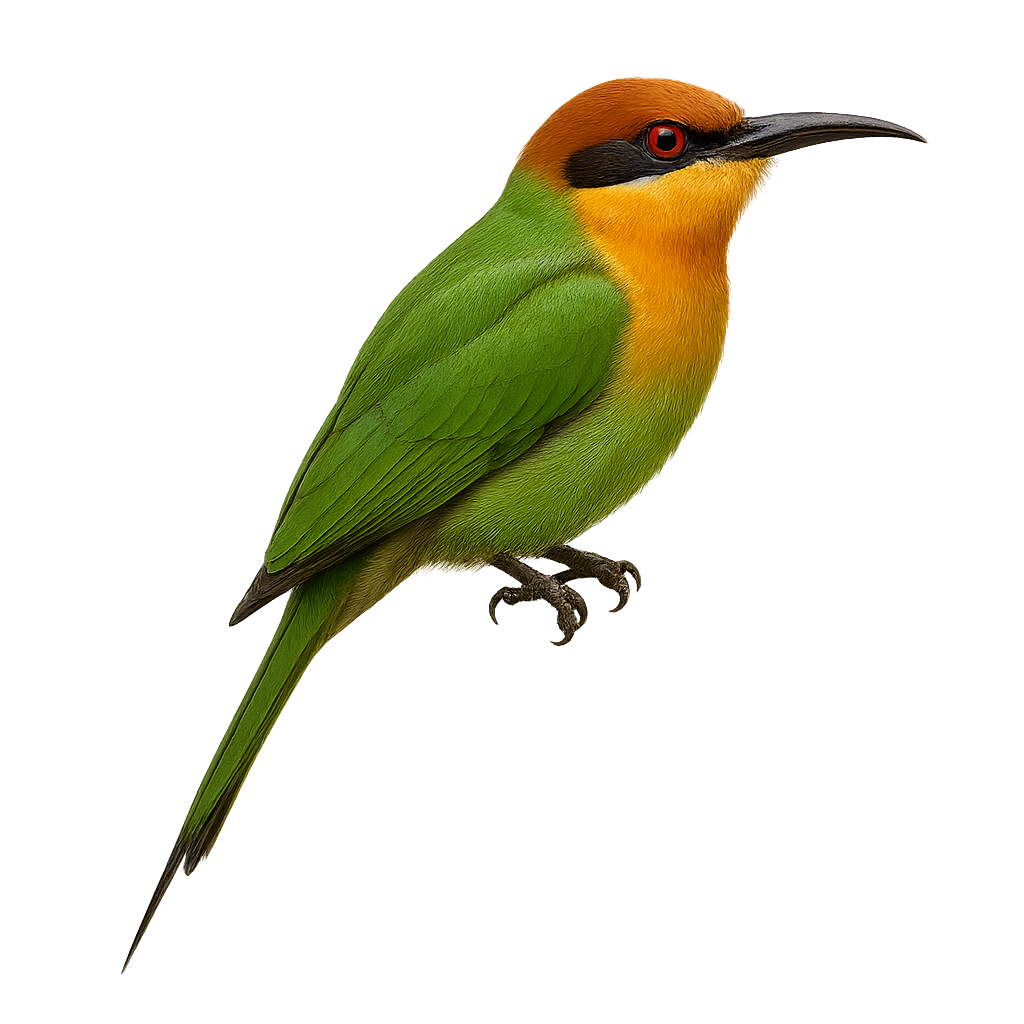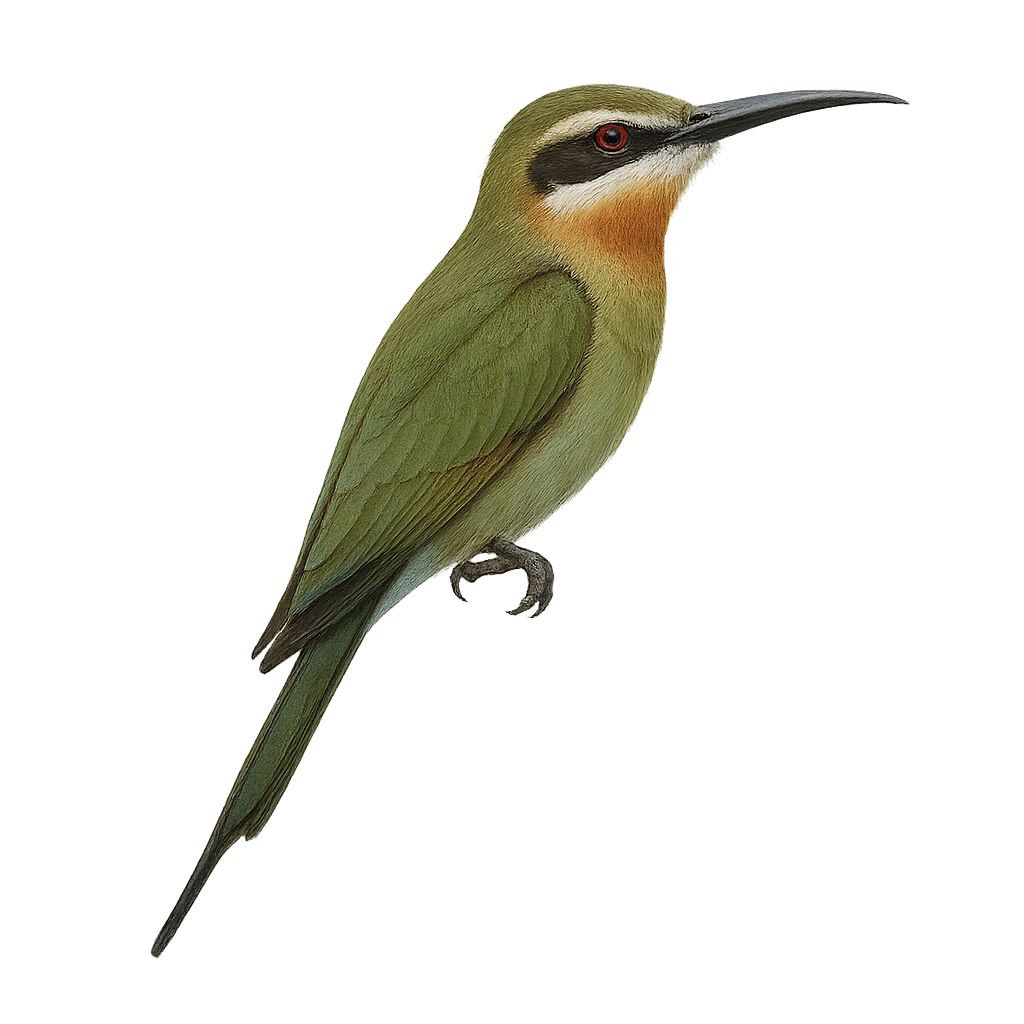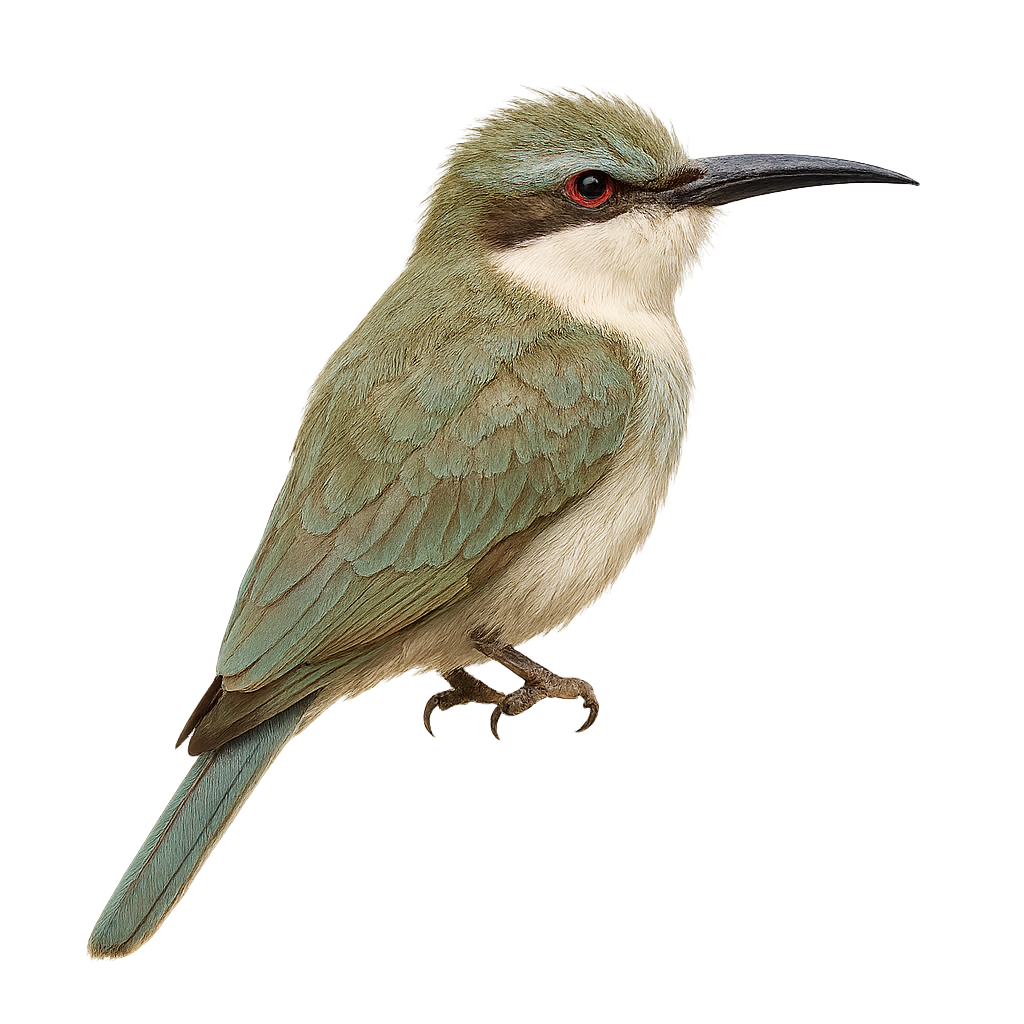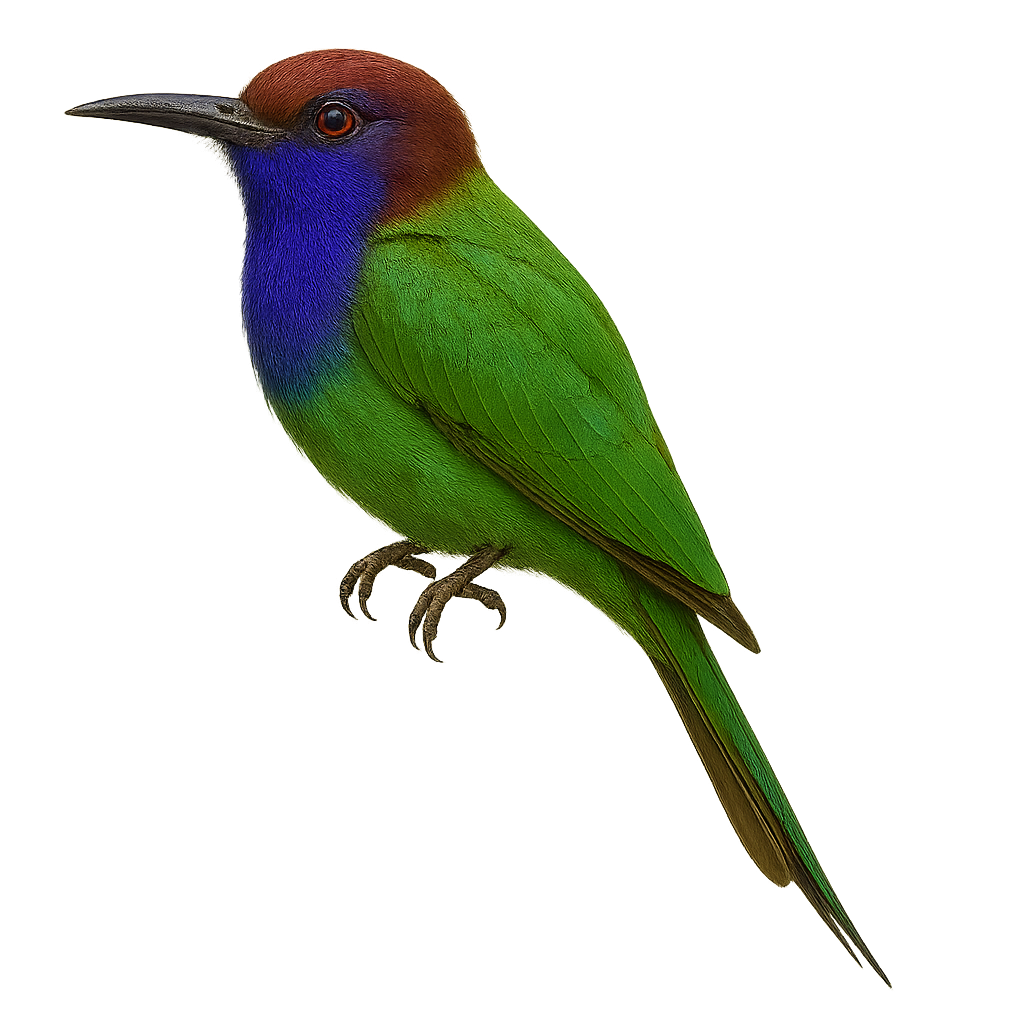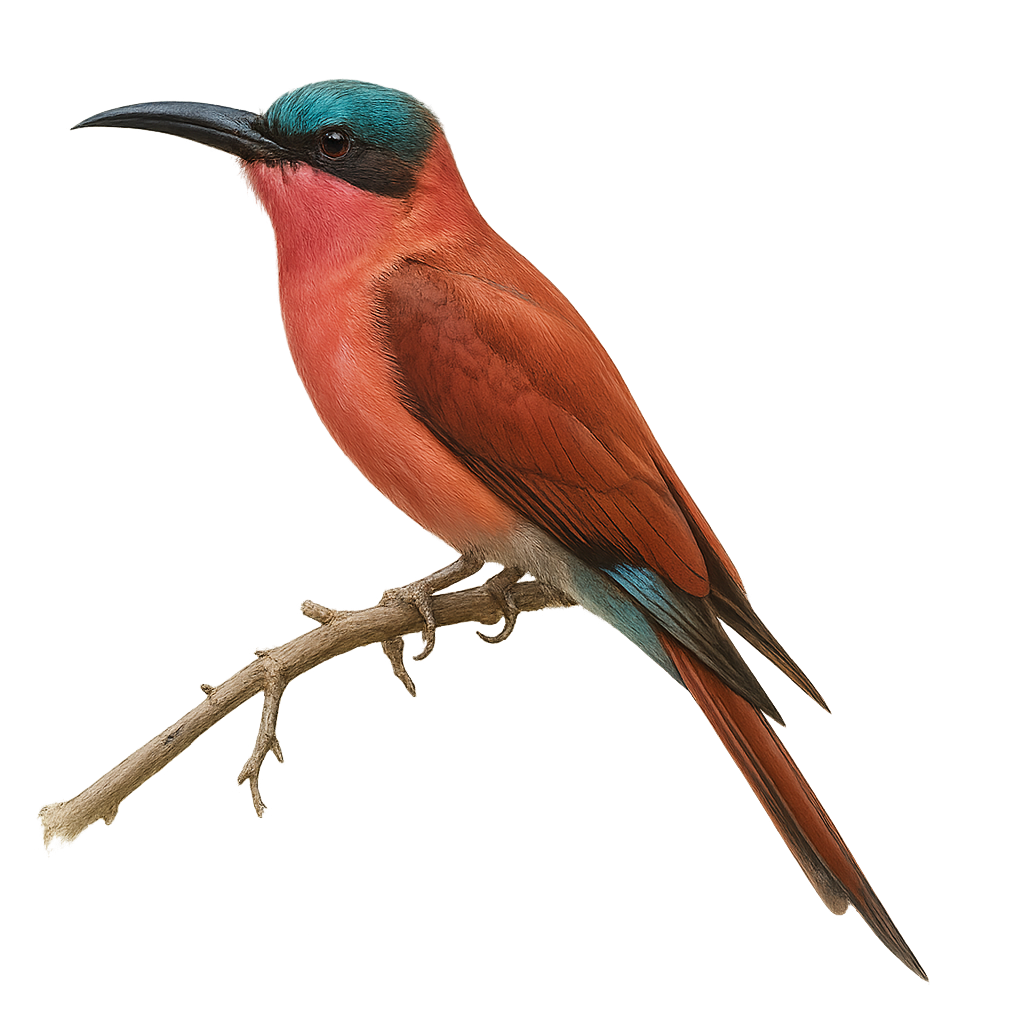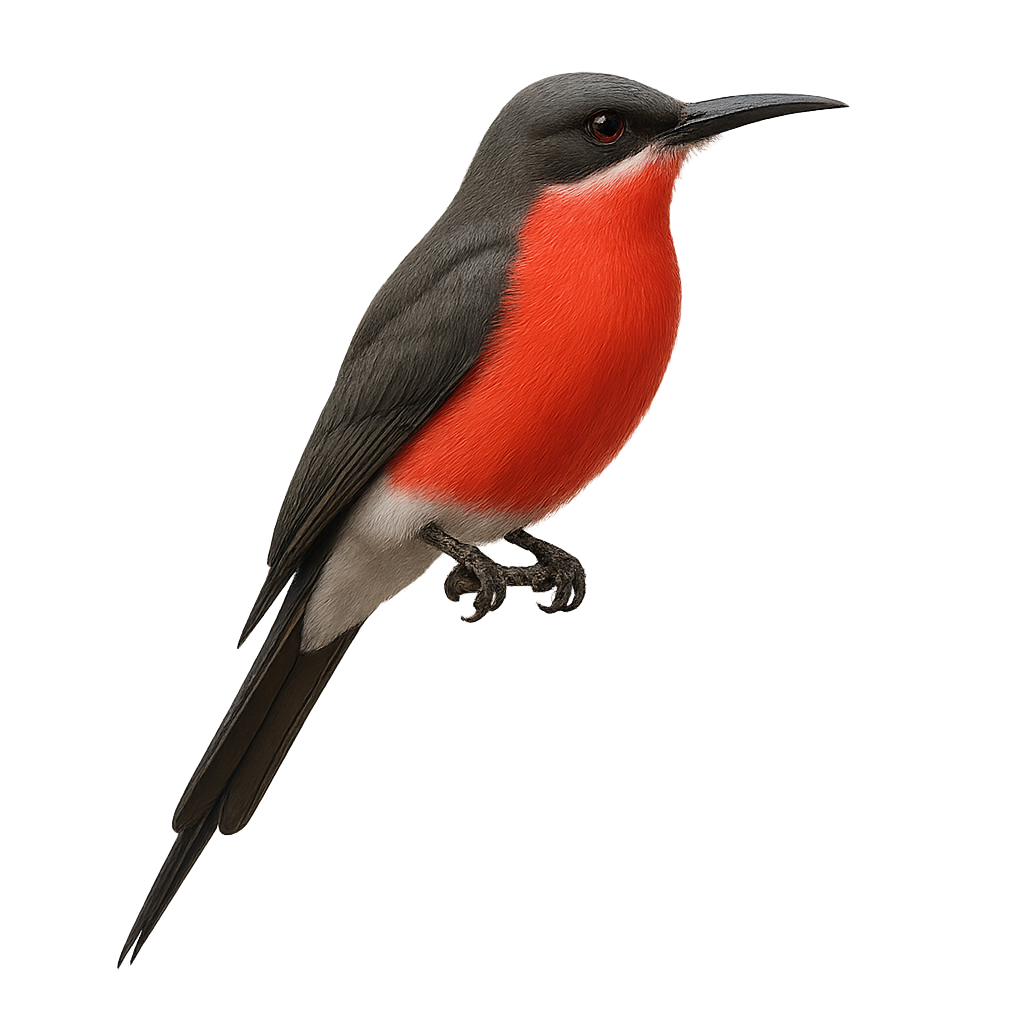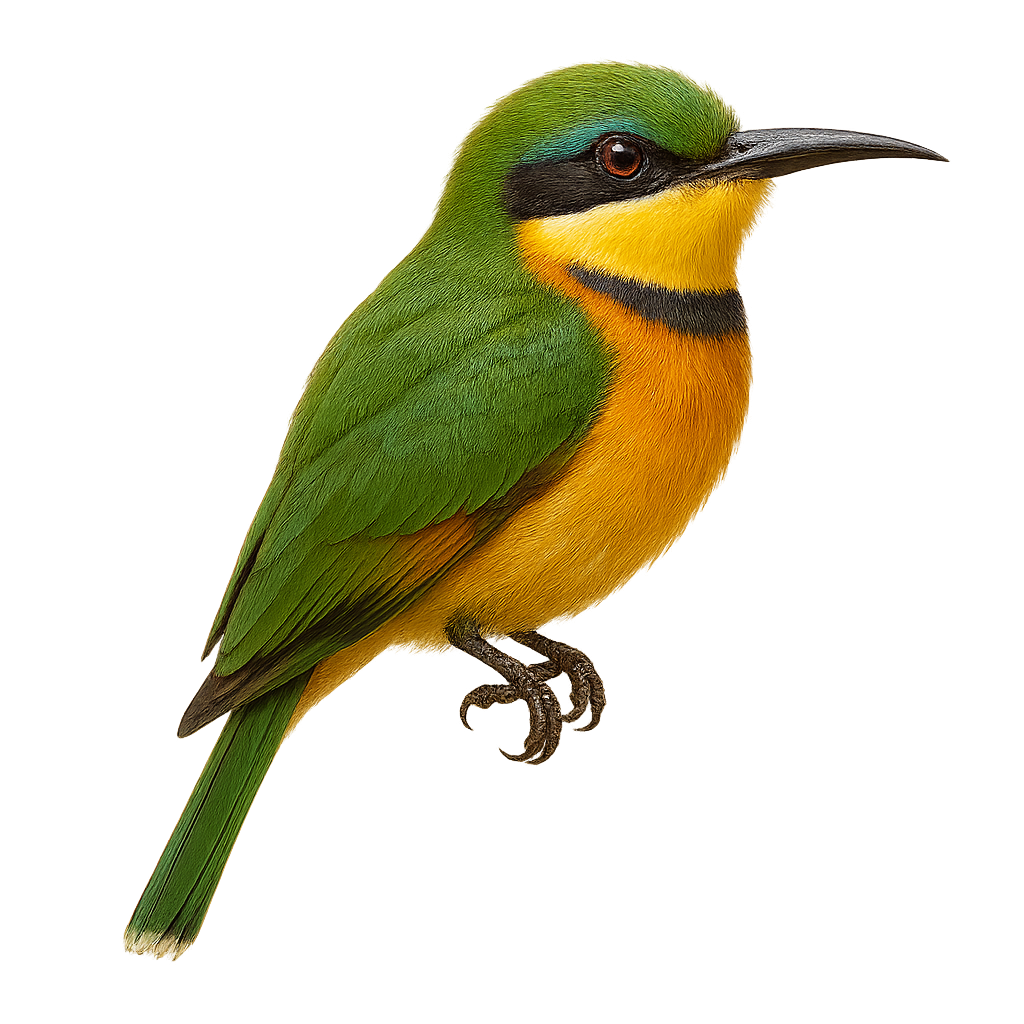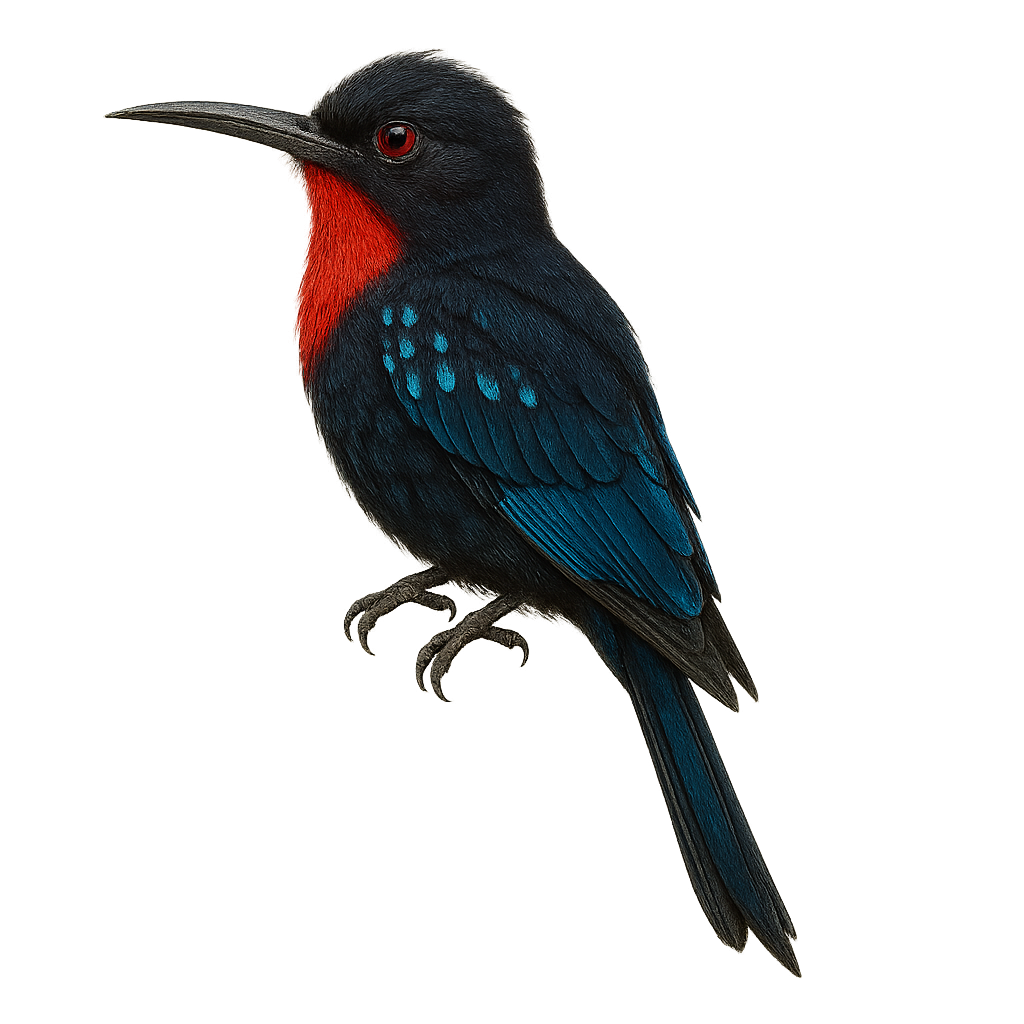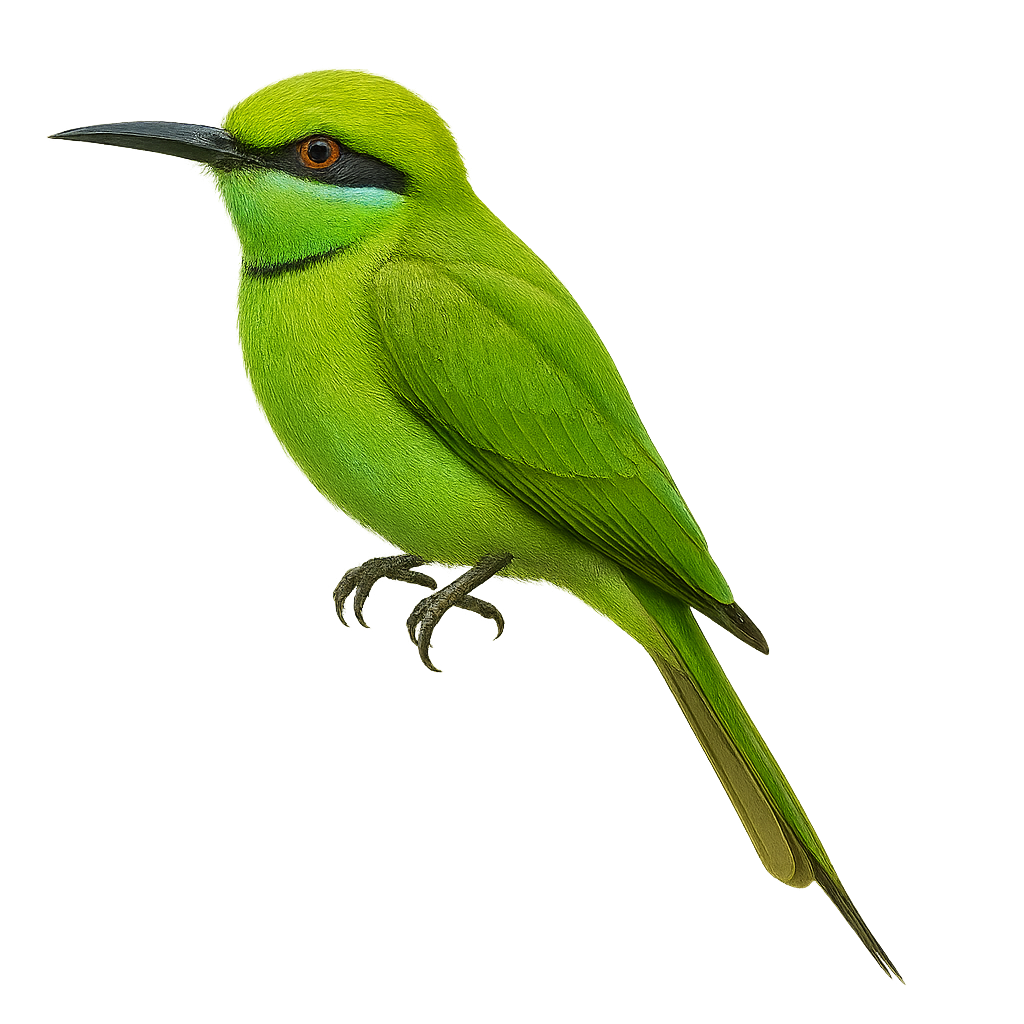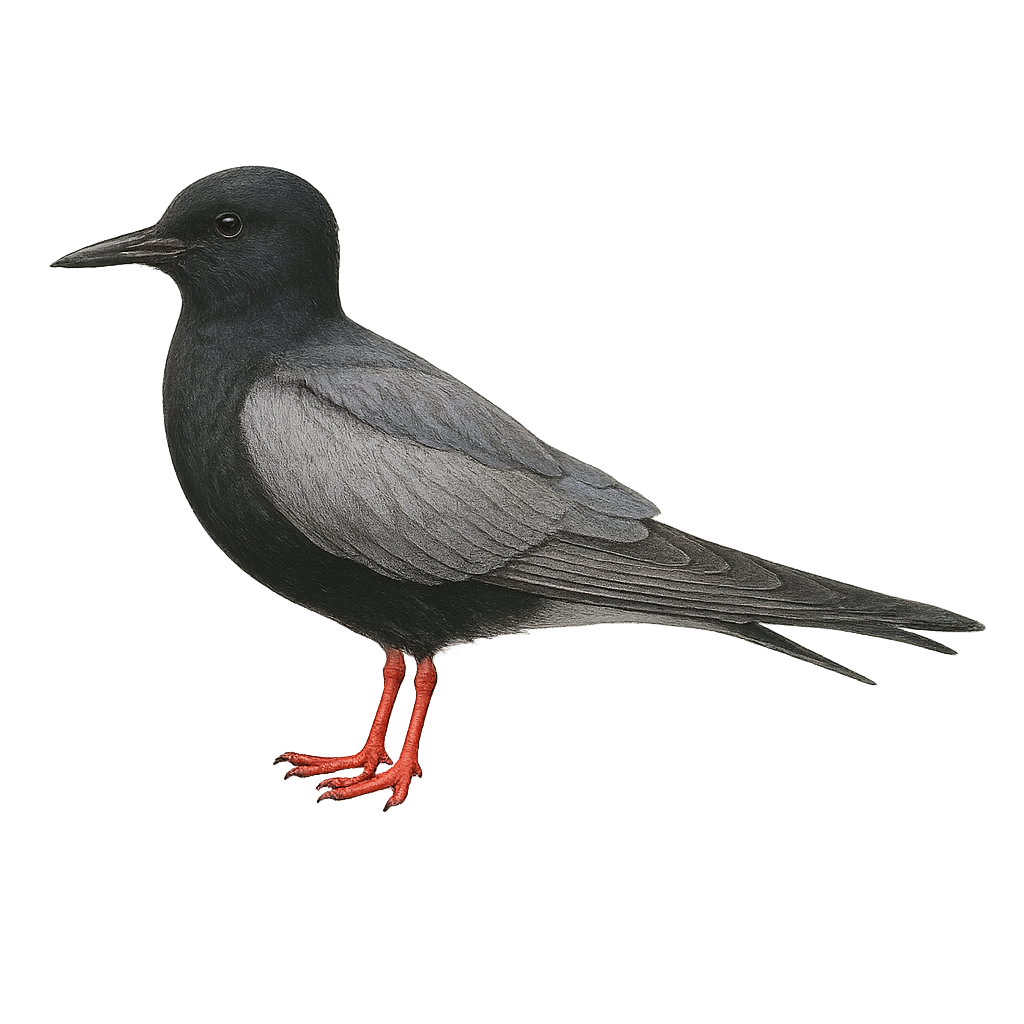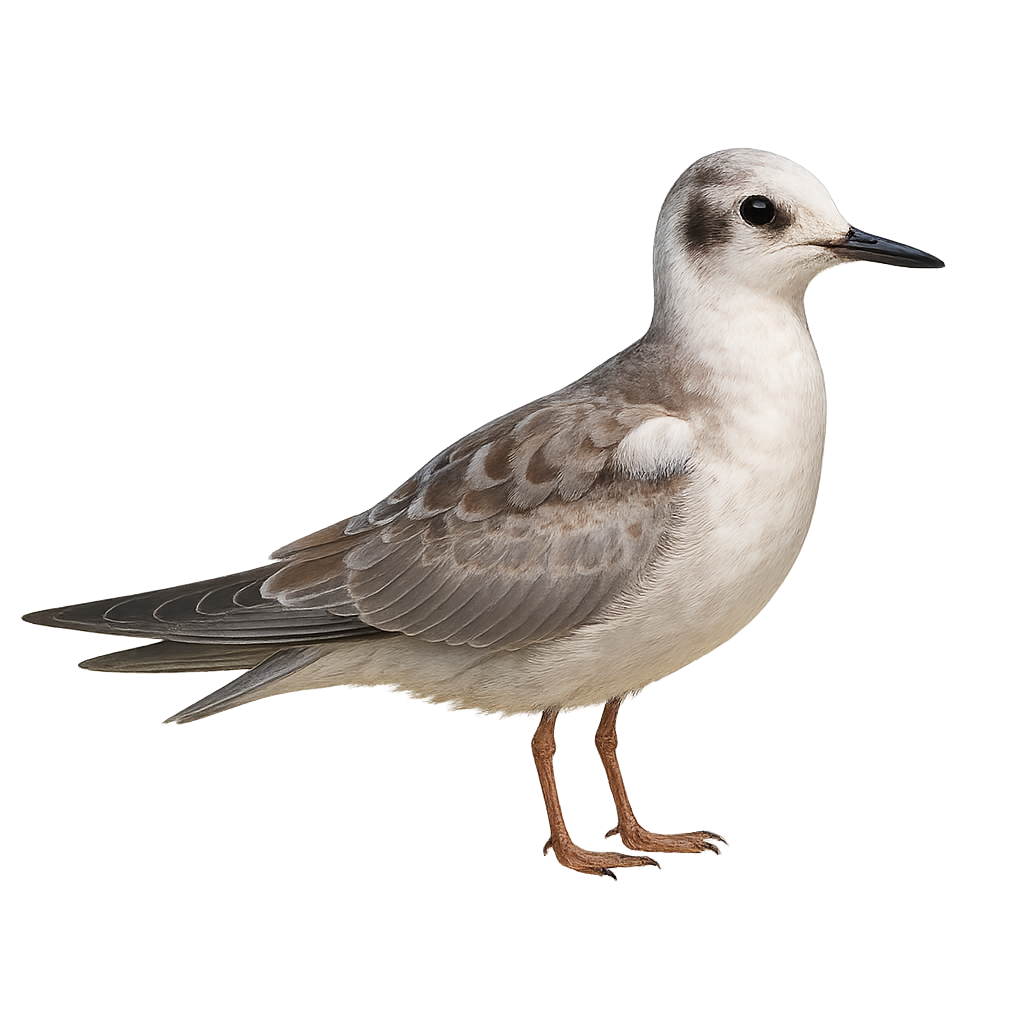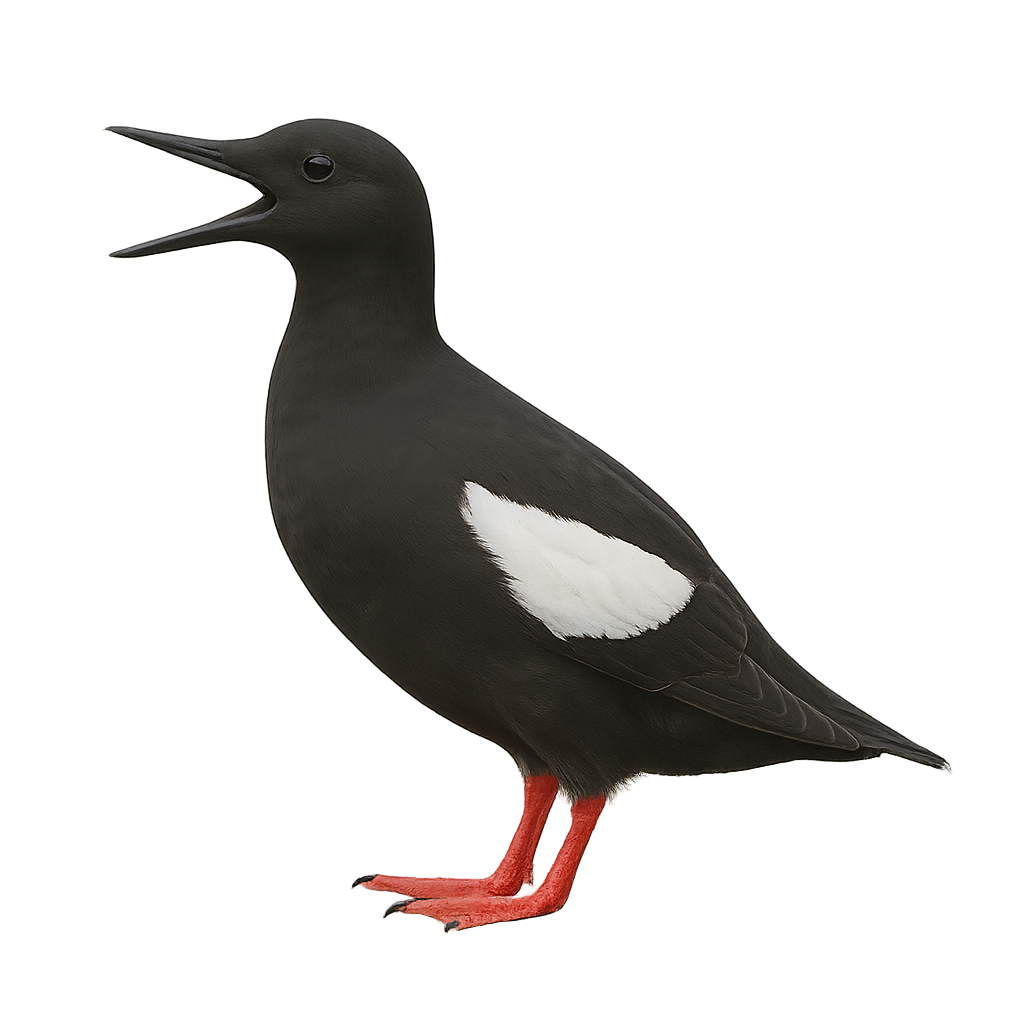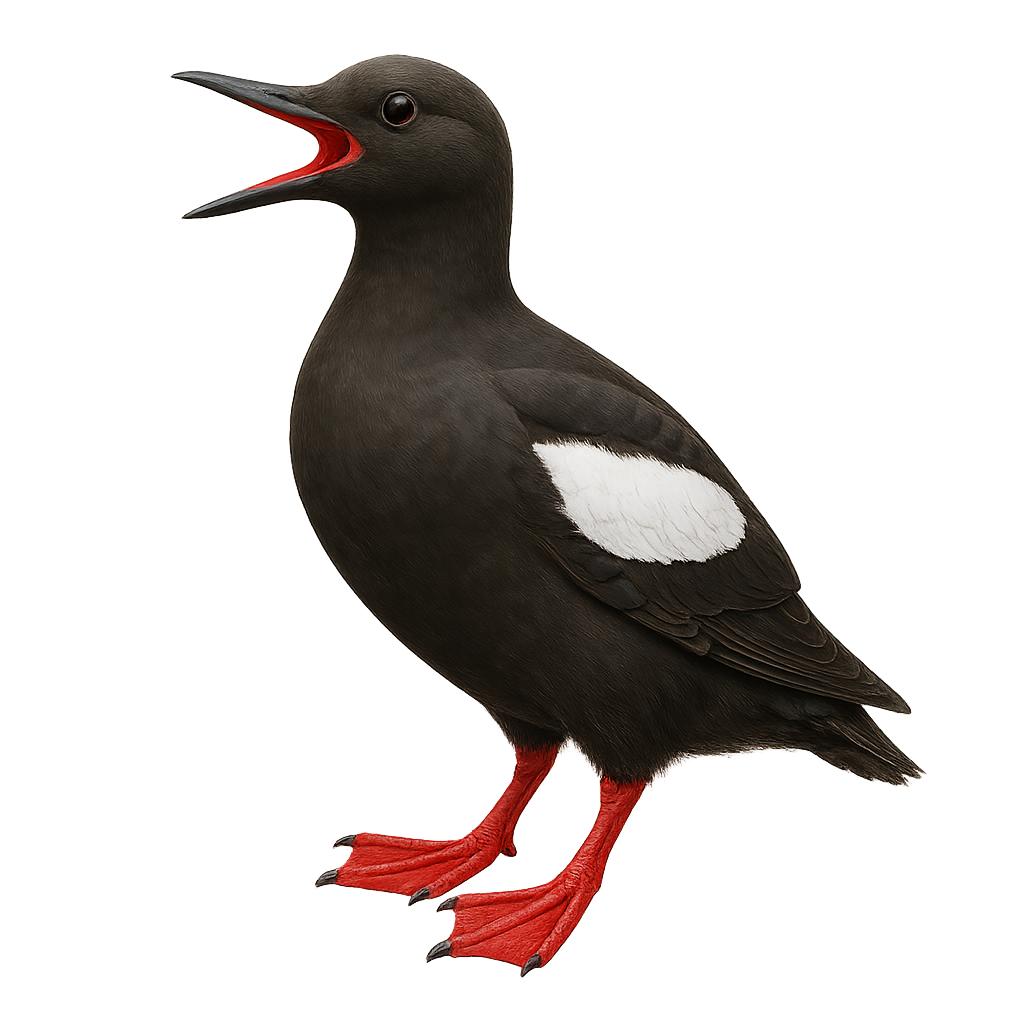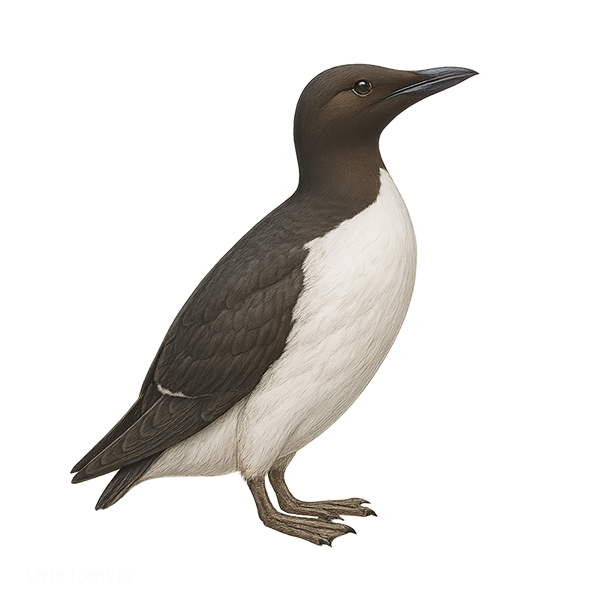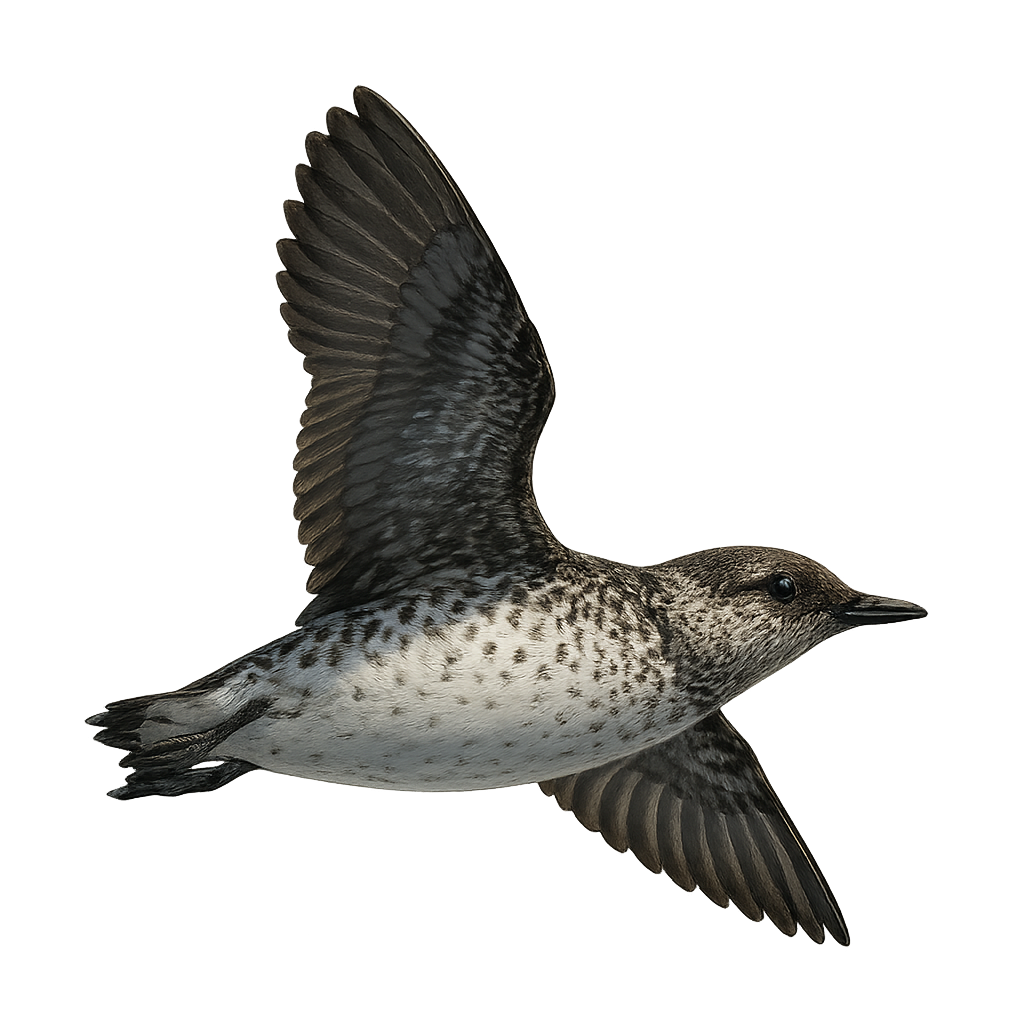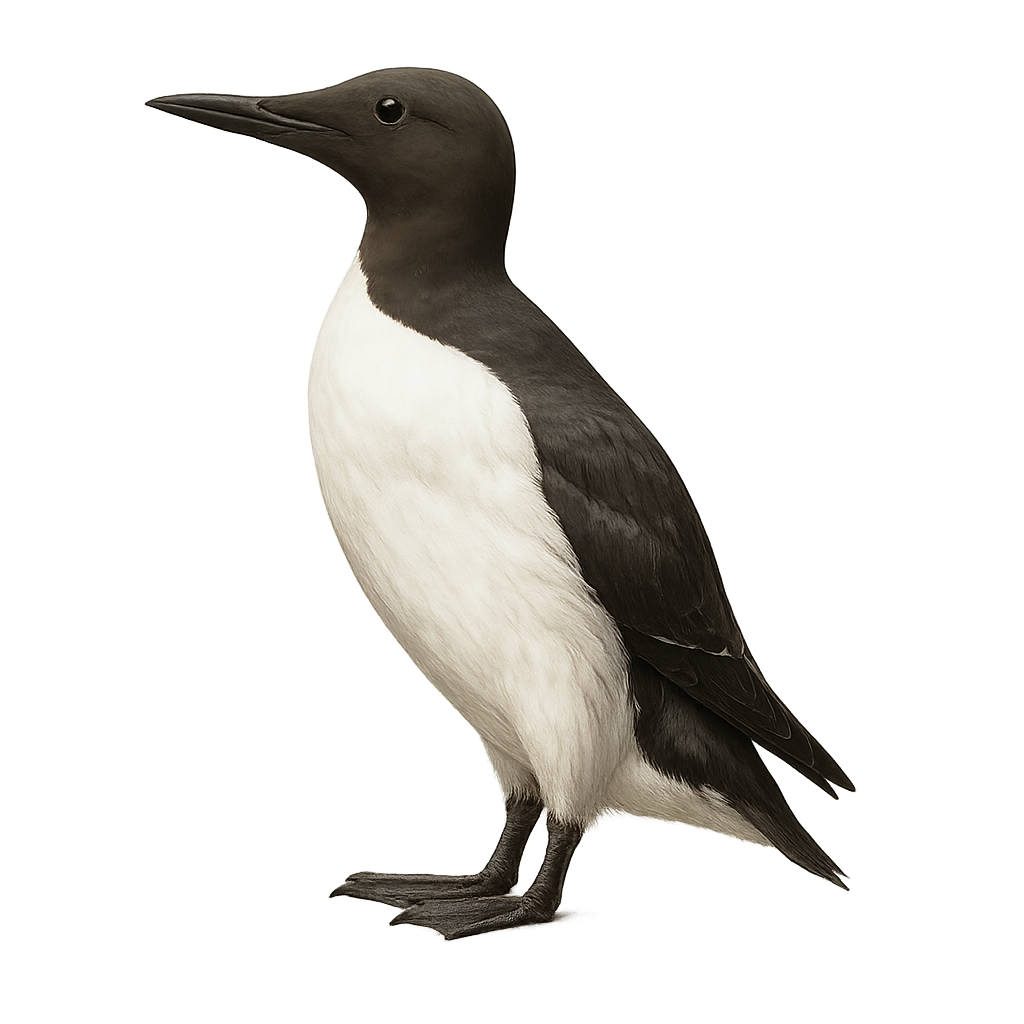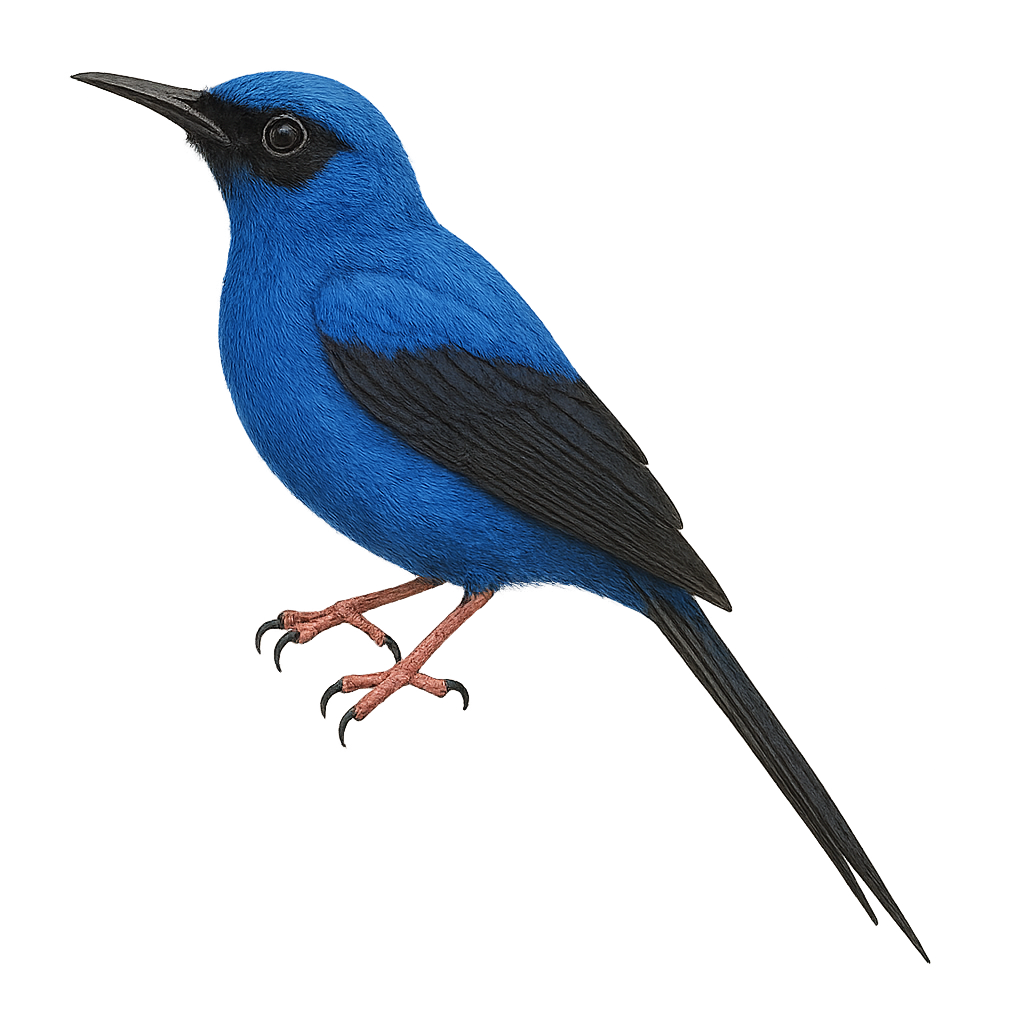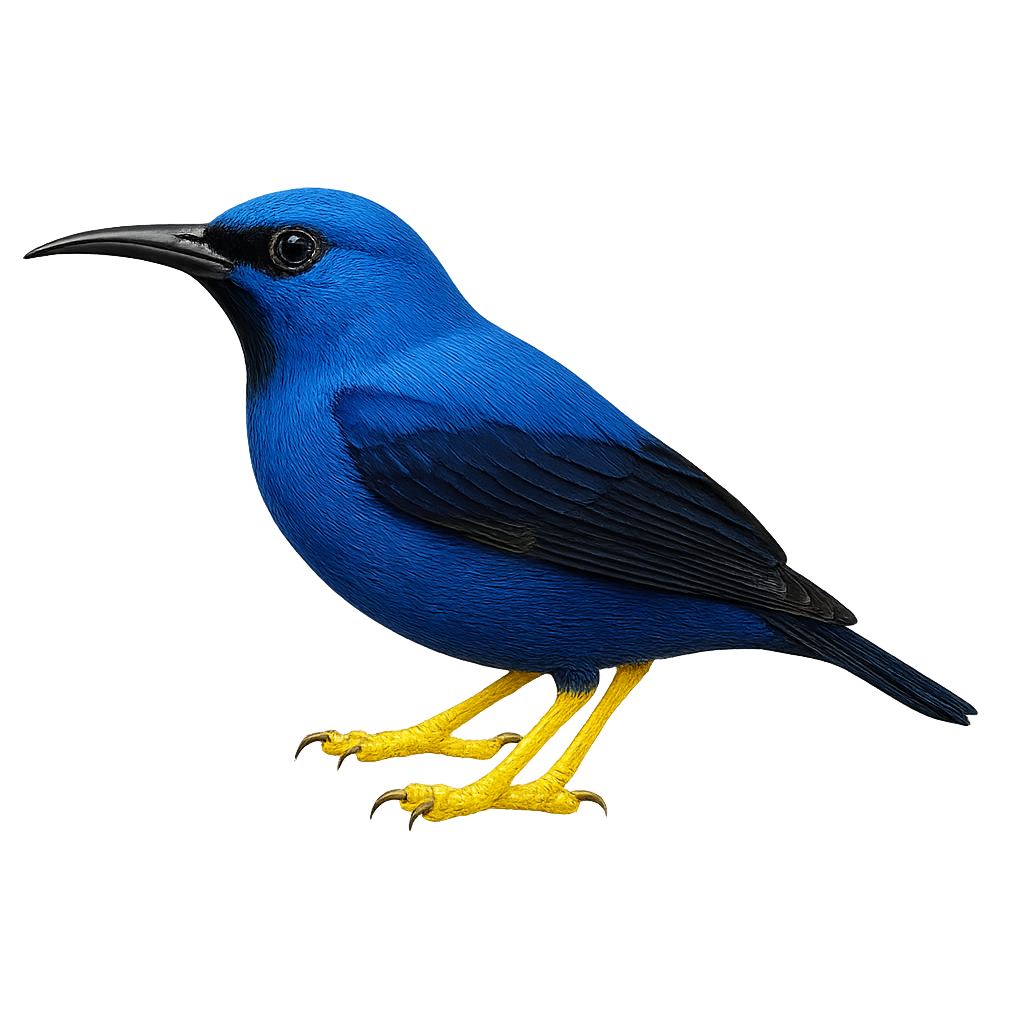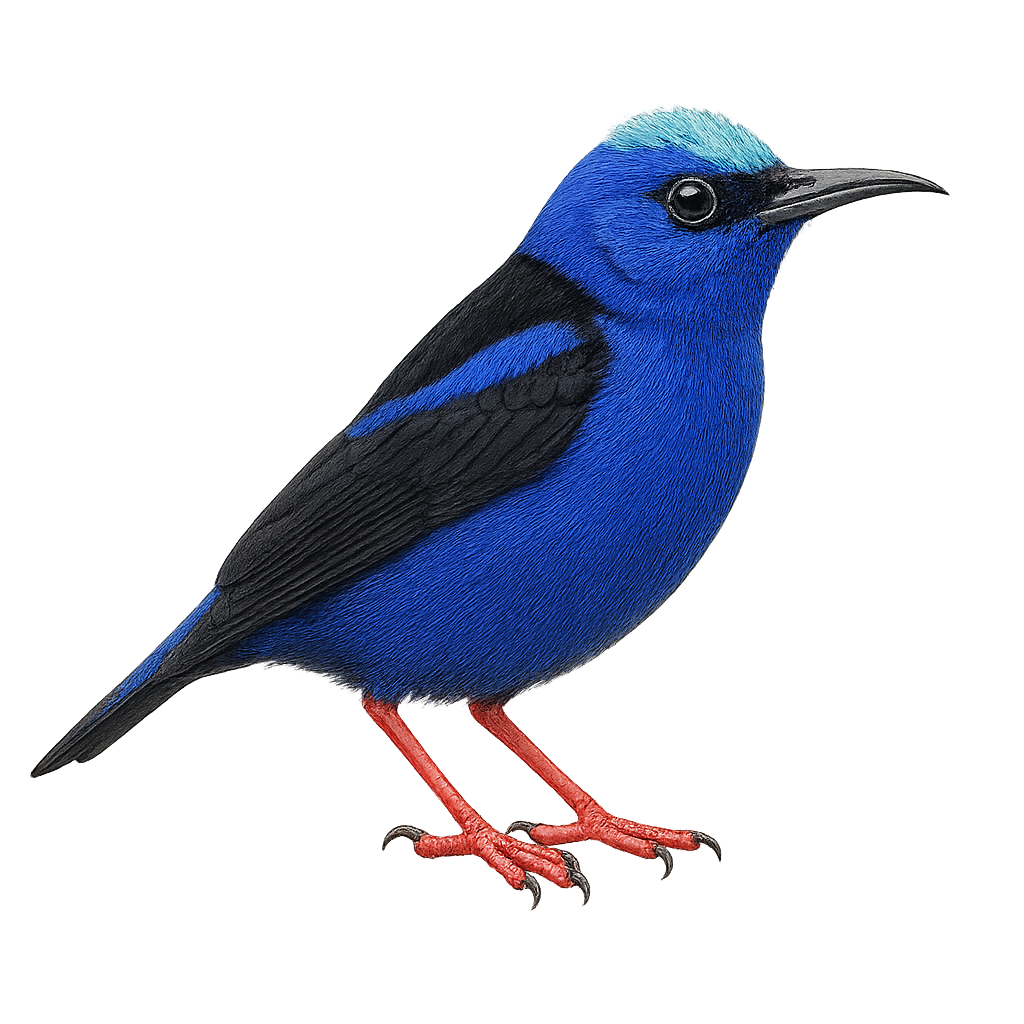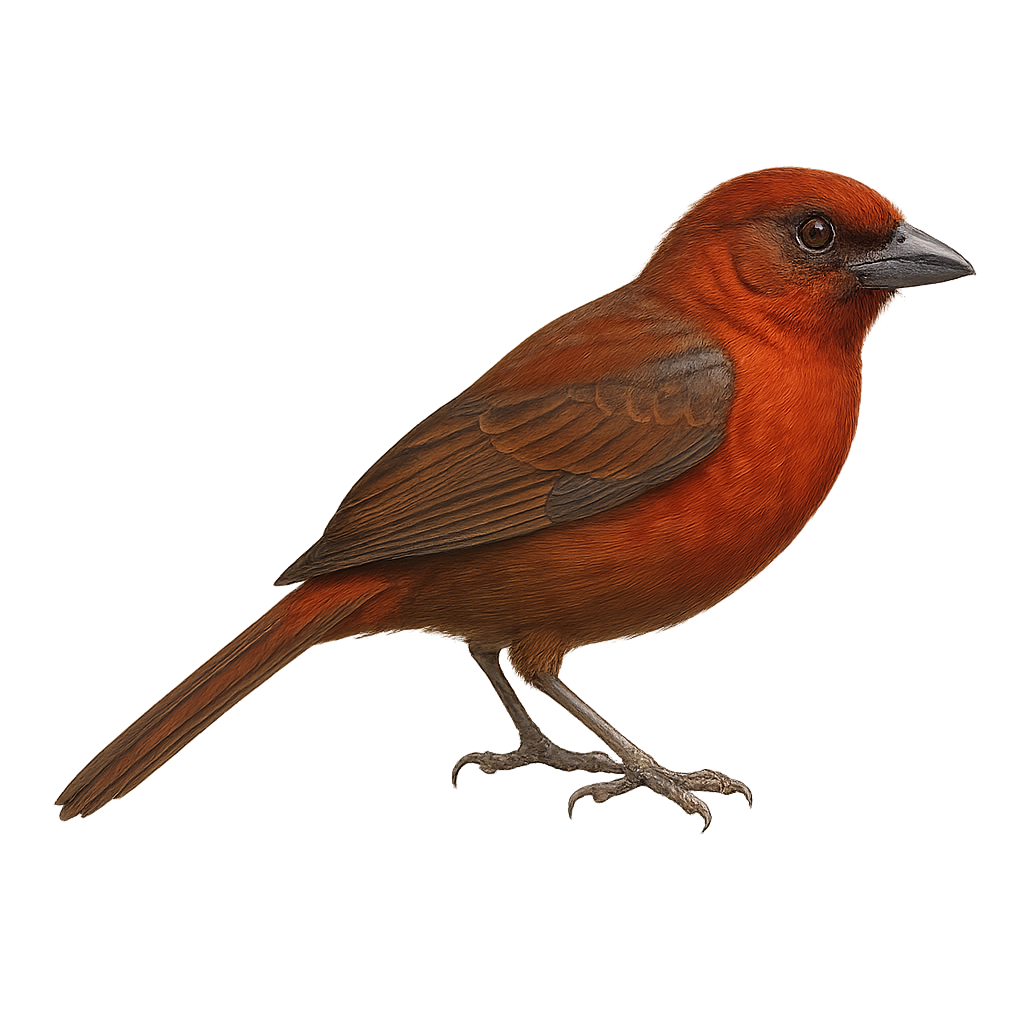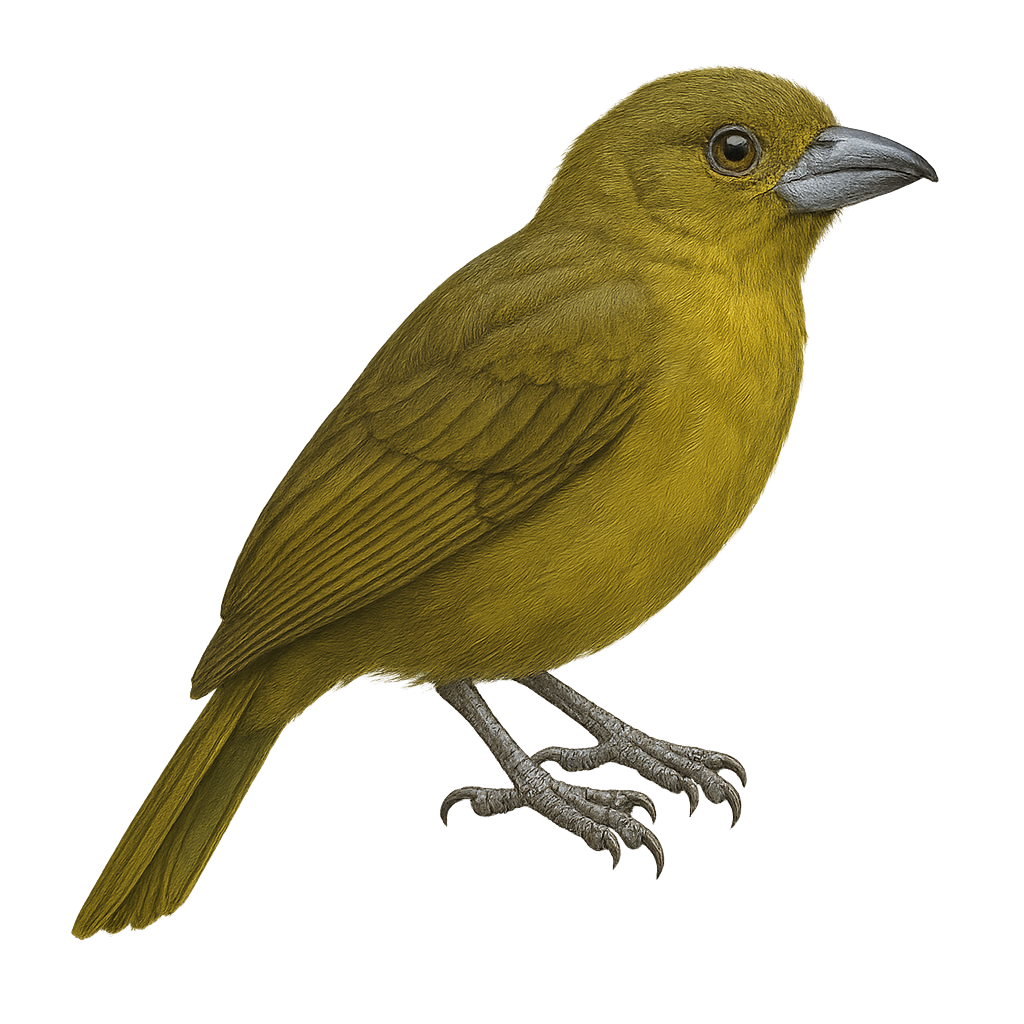The Northern Carmine Bee-eater, Merops nubicus, is a striking bird with vibrant colors, primarily carmine red with blue-green wings and tail. Known for its graceful flight, it skillfully catches insects mid-air, particularly bees and wasps. This sociable bird lives in colonies along rivers and lakes in sub-Saharan Africa, digging burrows in sandy banks for nesting. It is a partial migrant, moving seasonally to follow prey availability. Although its habitat is threatened by human activity, it is currently listed as Least Concern by the IUCN.
The European Bee-eater is a small, colorful bird, easily recognizable by its vibrant plumage, which features a combination of bright colors, mainly blue, green, yellow, and orange. It measures about 28 to 30 cm in length, with a wingspan of 40 to 45 cm, and weighs between 30 and 40 g. Its beak is long and pointed, perfectly adapted to catching insects in flight, primarily wasps, bees, and other flying insects. The European Bee-eater primarily inhabits open areas, grasslands, forest edges, and steppes in Europe, as well as North Africa and Western Asia. It is migratory and mostly travels to sub-Saharan Africa for the winter. This small bird lives in colonies, and its nests are often dug into cliffs or riverbanks. The European Bee-eater is known for its swift flights and acrobatic behavior while capturing its prey. Although the species is not endangered, it may be threatened by habitat loss and human disturbances, such as the degradation of natural habitats.
The Asian Green Bee-eater, or Merops orientalis, is a vibrant and graceful bird, easily recognized by its bright green plumage, blue throat, and black eye stripe. Measuring about 23 cm in length, it has a slender, slightly curved beak, perfect for catching insects in flight. This bird is often seen in small groups, perching on exposed branches to watch for prey. It is particularly common in open regions, savannas, and agricultural areas. The Asian Green Bee-eater is a partial migrant, moving according to the seasons to find food resources. Its presence is an indicator of the health of local ecosystems.
The Boehm's Bee-eater, or Merops boehmi, is a colorful and fascinating bird, primarily found in the wooded regions and savannas of Central and East Africa. It is distinguished by its vibrant plumage, blending shades of green, blue, and yellow, with a long, tapered tail. This bee-eater is a specialized insectivore, feeding mainly on bees and other flying insects, which it skillfully captures in flight. Sociable by nature, it often lives in small colonies and nests in burrows dug into sandy banks. Its melodious song and aerial acrobatics make it a captivating sight for nature observers.
The Chestnut-headed Bee-eater is a colorful and fascinating bird belonging to the Meropidae family. It is distinguished by its chestnut-colored head, bright green back, and vivid yellow throat. Its tail is long and tapered, often adorned with elongated central feathers. This bird is primarily insectivorous, feeding on various flying insects, especially bees and wasps, which it catches in flight with remarkable agility. It is found in open forests, woodlands, and grasslands of South and Southeast Asia. The Chestnut-headed Bee-eater is a sociable bird, often seen in groups, and it nests in burrows dug into sandy banks.
The Madagascar Bee-eater, Merops superciliosus, is a colorful and fascinating bird, primarily found in Madagascar and parts of East Africa. It is distinguished by its vibrant plumage, featuring shades of green, blue, and rufous, as well as its long, slender tail. This bird is often seen in flight, catching insects mid-air with its thin, curved beak. It typically nests in burrows dug into sandy banks, forming noisy and dynamic colonies. The Madagascar Bee-eater is a diurnal bird, active mainly during the day, and is known for its social behaviors and spectacular courtship displays.
The Blue-cheeked Bee-eater, or Merops persicus, is a strikingly colorful bird known for its vivid green plumage, blue throat, and distinctive black eye stripe. Measuring about 28 to 30 cm in length, it features long, pointed wings and a forked tail. This migratory bird primarily feeds on flying insects, especially bees, wasps, and dragonflies, which it catches in flight with remarkable agility. It inhabits open areas, savannas, and riverbanks, often seen in groups. During the breeding season, it digs burrows in sandy banks for nesting. The Blue-cheeked Bee-eater is a fascinating sight for birdwatchers and nature enthusiasts.
The Somali Bee-eater is a colorful bird, primarily green with shades of blue and yellow, and a reddish throat. It is endemic to the arid regions of the Horn of Africa, particularly in Somalia and northeastern Kenya. This bird is often seen in small groups, perching on exposed branches from where it hunts flying insects. Its flight is fast and agile, allowing it to catch prey mid-air. The Somali Bee-eater is a social bird, often seen preening each other. It nests in burrows dug into sandy banks, where it lays its eggs. Although its population is stable, it is sensitive to habitat disturbances.
The Purple-bearded Bee-eater is a colorful and fascinating bird endemic to the forests of Sulawesi, Indonesia. It is distinguished by its purple beard and bright green plumage, which allow it to blend into the dense canopy. This bird measures about 25 cm in length and primarily feeds on insects, especially bees and wasps, which it catches in flight with its slender, elongated beak. The Purple-bearded Bee-eater is a sociable bird, often seen in small groups. It prefers humid forest habitats and wooded areas at mid-altitude. Although its conservation status is concerning due to deforestation, it remains relatively common in some protected areas.
The Southern Carmine Bee-eater, Merops nubicoides, is a vibrant and captivating bird found primarily in southern Africa. It is distinguished by its bright red plumage, turquoise head, and long, tapered tail. This bee-eater is about 35 cm long, with a slightly curved black bill, perfect for catching insects in flight. It frequents sandy riverbanks and open savannas, where it digs burrows for nesting. Sociable by nature, it lives in colonies and feeds mainly on bees and wasps, which it catches in mid-air. Its flight is fast and agile, often accompanied by high-pitched calls. This beautiful bird is a delight to watch, especially during its courtship displays.
The Rosy Bee-eater, Merops malimbicus, is a graceful member of the Meropidae family, found across Central and Western Africa. It inhabits tropical forests, open savannas, clearings, and riverbanks, often seen soaring above the canopy or perched in the open. This species is easily recognized by its long triangular wings, uniform grey upperparts, rosy-pink underparts, a black eye stripe, and a sharp white moustache. Partially migratory, it sometimes forms massive breeding colonies with over 20,000 pairs. It nests in tunnels dug into sandy riverbanks or sandbars. Its call consists of harsh, brief notes like tik and trrp, typical of bee-eaters.
The Mountain Bee-eater, Merops oreobates, is a colorful and fascinating bird belonging to the Meropidae family. It is primarily found in the mountainous regions of East Africa, where it inhabits montane forests and wooded areas. Its vibrant plumage, featuring shades of green, blue, and yellow, makes it easily recognizable. This bird primarily feeds on insects, especially bees and wasps, which it catches in flight with remarkable agility. The Mountain Bee-eater is a sociable bird, often seen in small groups. It nests in burrows dug into banks or sandy slopes. Although its conservation status is currently stable, deforestation and habitat loss could threaten its populations in the future.
The Little Bee-eater, Merops pusillus, is a vibrant and fascinating bird, easily recognizable by its bright green plumage, yellow throat, and distinctive black eye stripe. Measuring about 15 to 17 cm in length, it is one of the smallest members of its family. It primarily inhabits savannas, open woodlands, and riverine areas in sub-Saharan Africa. The Little Bee-eater is an agile predator, feeding mainly on flying insects, especially bees and wasps, which it catches in flight. It is often seen in small groups, perched on low branches, from where it launches to catch its prey. Although relatively tolerant of human presence, it remains cautious and prefers to keep its distance.
The Black-headed Bee-eater, Merops gularis, is a fascinating bird belonging to the Meropidae family. This bee-eater is distinguished by its black head contrasting with its bright red throat and vibrant green plumage. It is primarily found in the humid tropical forests of West Africa, where it feeds mainly on flying insects, particularly bees and wasps. Its flight is agile and swift, allowing it to catch prey mid-air. Although its habitat is relatively stable, deforestation poses a threat to its population. The Black-headed Bee-eater is a sociable bird, often seen in small groups, and is known for its melodious and varied vocalizations.
The Persian Green Bee-eater, Merops viridissimus, is a colorful and graceful bird, primarily green with shades of blue and yellow. Known for its long central tail feathers and curved beak, it is adept at catching insects mid-flight. This bee-eater inhabits mainly arid and semi-arid regions, favoring open areas with sparse trees. Often seen in small groups, it perches on exposed branches. Its flight is agile and swift, allowing it to catch prey in mid-air. The Persian Green Bee-eater is also noted for its melodious calls, often heard during its flights.
The White-winged Tern, Chlidonias leucopterus, is an elegant bird from the Laridae family, recognizable by its white wings contrasting with its black body during the breeding season. It primarily inhabits wetlands, marshes, and lakes, where it feeds on insects and small fish. This migratory bird is found in Eastern Europe and Asia during the breeding season, before migrating to Africa and South Asia for the winter. Its population is generally stable, although threats such as habitat destruction and pollution can affect it locally. The White-winged Tern is a fascinating bird to observe, especially during its aerial acrobatics over water bodies.
The black tern is a small tern of 23–26 cm with contrasting black and white breeding plumage and a slender body. It inhabits freshwater wetlands, marshes and shallow lakes, feeding on insects and small fish caught in flight by pattering over the water surface. During breeding, it nests on floating vegetation, lays 2–4 eggs and defends its territory with swift aerial displays and sharp calls.
The Black Guillemot is a medium-sized seabird, measuring between 32 and 38 cm in length with a wingspan of 49 to 58 cm. In breeding plumage, it has a black body with a large white wing patch, bright red feet, and a red interior to its bill. In winter, its plumage becomes paler, with a light grey back and head and white underparts. It inhabits rocky coasts of the North Atlantic and Arctic, nesting in crevices of cliffs or under rocks. Its diet mainly consists of fish, crustaceans, and mollusks, which it captures by diving up to 50 meters deep. Although listed as Least Concern by the IUCN, it is sensitive to marine pollution and predation by introduced species.
The Pigeon Guillemot, Cepphus columba, is a medium-sized seabird belonging to the Alcidae family. It is primarily black with distinctive white wing patches and red legs. Its slender, pointed bill is adapted for catching small fish and marine invertebrates. Found mainly along the rocky coasts of the North Pacific, from Alaska to California, it is known for its impressive diving abilities, reaching significant depths to hunt its prey. During the breeding season, it nests in rocky crevices, often in scattered colonies. The Pigeon Guillemot is a resilient bird, well-adapted to its marine environment, but remains sensitive to human disturbances and environmental changes.
The Thick-billed Murre, or Uria lomvia, is a robust seabird found in the cold waters of the Arctic and subarctic regions. It is identifiable by its distinctive black and white plumage, with a black back and white belly, as well as its thick, short bill. This bird is an excellent diver, capable of reaching impressive depths to catch fish and crustaceans, which make up the bulk of its diet. Breeding colonies are typically located on steep cliffs, where the birds nest in large groups to protect themselves from predators. Although currently listed as Least Concern by the IUCN, the Thick-billed Murre is vulnerable to climate change and marine pollution, which threaten its natural habitat.
The Kittlitz's Murrelet, or Brachyramphus brevirostris, is a discreet seabird belonging to the Alcidae family. It is primarily found in the cold waters of Alaska and the Russian Far East. This bird is distinguished by its marbled brown breeding plumage and white belly, while its winter plumage is more subdued with grayish tones. Its compact size and short bill are well-suited to its marine lifestyle. It primarily feeds on small fish and marine invertebrates. The Kittlitz's Murrelet is known for its ability to nest far from the coast, often on rocky slopes or cliffs, making it difficult to observe. Its population is vulnerable due to climate change and marine pollution.
The Common Guillemot is a seabird characterized by its black and white plumage, and its streamlined body which allows it to swim with agility. It measures about 40 to 45 cm in length and weighs between 500 and 700 g. Its head is black with sharp white eyes, and its wings are short and pointed, suited for diving. The Common Guillemot primarily lives on coastal cliffs, where it nests in very dense colonies, often on inaccessible sites. It is found mainly in Northern Europe, particularly in Scandinavia, the United Kingdom, and Iceland, but also along the coasts of the North Atlantic. The Common Guillemot is an excellent diver, primarily feeding on fish, particularly small herring and capelin, which it catches by diving underwater in search of prey. While the species is not endangered, it is vulnerable to marine pollution, climate change, and disruption of its breeding sites.
The Marbled Murrelet, Brachyramphus marmoratus, is a discreet and fascinating seabird belonging to the Alcidae family. It is primarily observed along the North Pacific coasts, from Alaska to California. This small bird, measuring about 25 cm in length, is recognizable by its marbled brown and white plumage, which allows it to blend effectively into its environment. Unlike most other alcids, the Marbled Murrelet nests in old-growth forests, often several kilometers from the sea, where it lays a single egg on a tree branch. It primarily feeds on small fish and marine invertebrates, which it skillfully captures by diving underwater. Unfortunately, this species is threatened by the loss of its forest habitat and human disturbances.
The Shining Honeycreeper, Cyanerpes nitidus, is a small, vibrant tropical bird, primarily electric blue with black wings and tail. Males display a striking plumage, while females are generally duller, with green and yellow hues. This bird is commonly found in the humid tropical forests of South America, particularly in Brazil, Colombia, and Venezuela. It primarily feeds on nectar but also consumes insects and fruits. Its slender, curved beak is perfectly adapted for extracting nectar from flowers. The Shining Honeycreeper is an active and social bird, often seen in small groups or pairs.
The Cyanerpes lucidus, or Shining Honeycreeper, is a small tropical bird with vibrant colors, primarily blue with black wings and a slender, curved beak. This nectarivore primarily feeds on nectar but also consumes fruits and insects. It is found in the humid forests and forest edges of Central America, from southern Mexico to Panama. Males display a striking blue plumage, while females are more subdued in green. Their behavior is generally active and social, often seen in small groups. They play a crucial role in pollinating tropical plants.
The Purple Honeycreeper is a small tropical bird with vibrant plumage, primarily blue with shades of violet, and black wings. Males have a curved black bill, while females display a more subdued green plumage. This bird inhabits the humid forests of Central and South America, feeding mainly on nectar, fruits, and insects. Its behavior is generally active and sociable, often seen in small groups. It plays a crucial role in the pollination of tropical plants. Although not currently threatened, deforestation poses a potential risk to its natural habitat.
The Red-legged Honeycreeper, Cyanerpes cyaneus, is a small, vibrantly colored tropical bird, primarily electric blue with black wings and red legs. It is commonly found in the humid forests and wooded areas of Central and South America. This nectarivore feeds mainly on nectar but also consumes fruits and insects. Males display a striking plumage, while females are generally olive green with bluish hues. The Red-legged Honeycreeper is a social bird, often seen in small groups, and is known for its aerial acrobatics when feeding. Its breeding season varies by region but is generally active year-round in tropical areas.
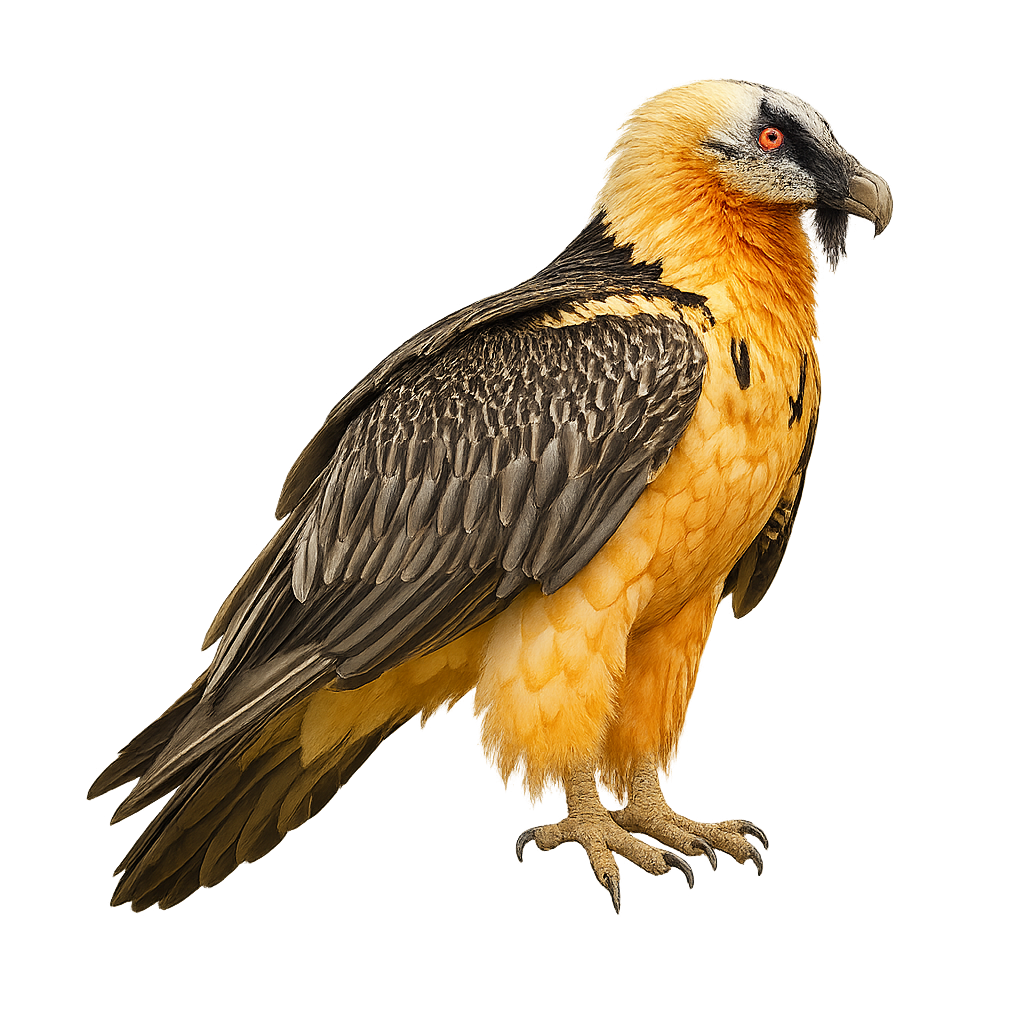
The Bearded Vulture is a large vulture, easily recognizable by its distinctive head, large wings, and brown and white plumage. It measures about 1.1 to 1.3 meters in length, with a wingspan of 2.6 to 2.8 meters, and weighs between 4.5 and 7.5 kg. Its head is covered with dark feathers, while its wings and back are mainly brown, with lighter feathers on its belly. The Bearded Vulture is unique among vultures for its feeding behavior, as it primarily feeds on bones. It is capable of breaking the hardest bones by dropping them from great heights to shatter them, allowing it to access the bone marrow. It primarily inhabits mountains, notably the Alps, the Pyrenees, and the Himalayas, where it also feeds on carcasses of dead animals, such as chamois or mouflons. Although the species was once endangered, conservation efforts have helped restore its population in certain areas. However, the Bearded Vulture remains vulnerable to human disturbance, habitat loss, and the decline of its natural prey.
The Red-throated Ant-tanager is a medium-sized bird, primarily recognized for its bright red throat in males, while females display more subdued tones. It is mainly found in the tropical and subtropical forests of Central America, favoring dense undergrowth. This bird is often seen in small groups, feeding on insects and fruits. Its song is a soft whistle, often heard at dawn. Although relatively common in its natural habitat, it remains discreet and difficult to spot due to its plumage that blends into the forest environment. Its ability to adapt to various forest habitats makes it a resilient species in the face of deforestation.
The Carmiol's Tanager is a medium-sized bird, measuring about 18 cm in length. It features primarily olive-green plumage, with darker shades on the wings and tail. Its head is marked by a grayish cap, and it has a robust, slightly hooked beak suited for its varied diet. This bird primarily feeds on fruits, insects, and small invertebrates. It is mainly found in the humid forests and wooded areas of Central America, particularly in Costa Rica and Panama. The Carmiol's Tanager is often seen in small groups, actively moving through the canopy in search of food. Although not considered threatened, deforestation poses a potential threat to its natural habitat.


